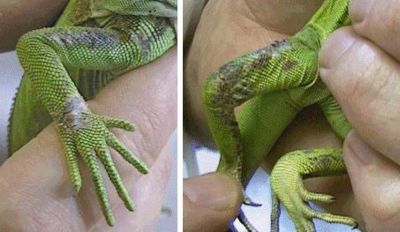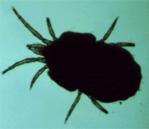Difference between revisions of "Lizard Mites"
Siobhanbrade (talk | contribs) m (added manson flashcard info) |
|||
| Line 6: | Line 6: | ||
==Mite Infestation== | ==Mite Infestation== | ||
| − | Ectoparasites are a common problem in captive lizards. Mite infestation may result in a pigmented 'black' dermatitis commonly known as "black skin disease", but ticks are rare. As the mites are usually quite ubiquitous, snake mites can infest lizards and vice versa. ''Hirstiella trombidiiformis'' is the common lizard mite. | + | Ectoparasites are a common problem in captive lizards. Mite infestation may result in a pigmented 'black' dermatitis commonly known as "black skin disease", but ticks are rare. As the mites are usually quite ubiquitous, snake mites can infest lizards and vice versa. ''Hirstiella trombidiiformis'' is the common lizard mite, and it can be differentiated from another common mite, ''Ophionyssus natricis'' by the presence of a pointed protruberance at the caudal end of its abdomen. |
===Clinical signs and Diagnosis=== | ===Clinical signs and Diagnosis=== | ||
| − | The ectoparasites can usually be found in the axillae and stifle skinfolds of lizards. The tissue damage created by the mite causes swelling, irritation, erythema and even secondary bacterial infection; the skin appears as raised areas of colour change on the skin, generally on the ventral abdomen and limbs. In more serious cases, mite infestation can lead to [[Lizard Dysecdysis|dysecdysis]] and transmission of bacterial and viral agents (e.g. ''[[Aeromonas species|Aeromonas hydrophila]]'' septicaemia, haemoparasites and inclusion body disease). | + | The ectoparasites can usually be found in the axillae and stifle skinfolds of lizards. The tissue damage created by the mite causes swelling, irritation, erythema and even secondary bacterial infection; the skin appears as raised areas of colour change on the skin, generally on the ventral abdomen and limbs. In more serious cases, mite infestation can lead to [[Lizard Dysecdysis|dysecdysis]], anaemia and transmission of bacterial and viral agents (e.g. ''[[Aeromonas species|Aeromonas hydrophila]]'' septicaemia, haemoparasites and inclusion body disease). |
Individual mites are visible on magnification. They can be seen moving on the host, sometimes in small numbers. They can also be found drowned in the affected animal's water dishes. | Individual mites are visible on magnification. They can be seen moving on the host, sometimes in small numbers. They can also be found drowned in the affected animal's water dishes. | ||
| Line 18: | Line 18: | ||
The animal and its environment need to be treated as a big part of the parasite's life cycle is spent off the host. | The animal and its environment need to be treated as a big part of the parasite's life cycle is spent off the host. | ||
| − | * Initially, a bath in warm water will rid the animal of some of the mites. | + | * Initially, a bath in warm water will rid the animal of some of the mites. Alternatively, a cotton bud sprayed with an insecticide (licensed for use in puppies and kittens) can be used to remove groups of mites. |
* Oral or subcutaneous ivermectin PO or SC, repeat in 2 weeks; the environment should also be sprayed with ivermectin diluted in water. | * Oral or subcutaneous ivermectin PO or SC, repeat in 2 weeks; the environment should also be sprayed with ivermectin diluted in water. | ||
| − | * Topical insecticides (e.g. Frontline) | + | * Topical insecticides (e.g. Frontline) can be applied using a sponge. |
===Prevention=== | ===Prevention=== | ||
* Preventive medicine including [[Lizard and Snake Quarantine|quarantine]] and appropriate [[Lizard Husbandry Requirements|husbandry]]. | * Preventive medicine including [[Lizard and Snake Quarantine|quarantine]] and appropriate [[Lizard Husbandry Requirements|husbandry]]. | ||
| + | |||
| + | {{Learning | ||
| + | |flashcards = [[Reptiles and Amphibians Q&A 21]] | ||
| + | }} | ||
==Literature Search== | ==Literature Search== | ||
| Line 36: | Line 40: | ||
[http://www.cabi.org/cabdirect/FullTextPDF/2009/20093118403.pdf ''' Reptile parasitology: what is that and how do I treat that?''' Wright, K.; The North American Veterinary Conference, Gainesville, USA, Small animal and exotics. Proceedings of the North American Veterinary Conference, Orlando, Florida, USA, 17-21 January, 2009, 2009, pp 1817-1821 - '''Full Text Article'''] | [http://www.cabi.org/cabdirect/FullTextPDF/2009/20093118403.pdf ''' Reptile parasitology: what is that and how do I treat that?''' Wright, K.; The North American Veterinary Conference, Gainesville, USA, Small animal and exotics. Proceedings of the North American Veterinary Conference, Orlando, Florida, USA, 17-21 January, 2009, 2009, pp 1817-1821 - '''Full Text Article'''] | ||
| + | ==References== | ||
| + | Frye, FL & Williams, DL (1995) '''Self-Assessment Colour Review - Reptiles & Amphibians''' ''Manson'' | ||
[[Category:Lizard Skin Diseases|M]] | [[Category:Lizard Skin Diseases|M]] | ||
| + | [[Category: To Do - Siobhan Brade]] | ||
| + | [[Category:To Do - Manson review]] | ||
Revision as of 09:38, 10 September 2011
| This article has been peer reviewed but is awaiting expert review. If you would like to help with this, please see more information about expert reviewing. |
Mite Infestation
Ectoparasites are a common problem in captive lizards. Mite infestation may result in a pigmented 'black' dermatitis commonly known as "black skin disease", but ticks are rare. As the mites are usually quite ubiquitous, snake mites can infest lizards and vice versa. Hirstiella trombidiiformis is the common lizard mite, and it can be differentiated from another common mite, Ophionyssus natricis by the presence of a pointed protruberance at the caudal end of its abdomen.
Clinical signs and Diagnosis
The ectoparasites can usually be found in the axillae and stifle skinfolds of lizards. The tissue damage created by the mite causes swelling, irritation, erythema and even secondary bacterial infection; the skin appears as raised areas of colour change on the skin, generally on the ventral abdomen and limbs. In more serious cases, mite infestation can lead to dysecdysis, anaemia and transmission of bacterial and viral agents (e.g. Aeromonas hydrophila septicaemia, haemoparasites and inclusion body disease).
Individual mites are visible on magnification. They can be seen moving on the host, sometimes in small numbers. They can also be found drowned in the affected animal's water dishes.
Treatment
The animal and its environment need to be treated as a big part of the parasite's life cycle is spent off the host.
- Initially, a bath in warm water will rid the animal of some of the mites. Alternatively, a cotton bud sprayed with an insecticide (licensed for use in puppies and kittens) can be used to remove groups of mites.
- Oral or subcutaneous ivermectin PO or SC, repeat in 2 weeks; the environment should also be sprayed with ivermectin diluted in water.
- Topical insecticides (e.g. Frontline) can be applied using a sponge.
Prevention
- Preventive medicine including quarantine and appropriate husbandry.
| Lizard Mites Learning Resources | |
|---|---|
 Test your knowledge using flashcard type questions |
Reptiles and Amphibians Q&A 21 |
Literature Search
Use these links to find recent scientific publications via CAB Abstracts (log in required unless accessing from a subscribing organisation).
Reptile ectoparasites - how to kill those little buggers. Greek, T.; The North American Veterinary Conference, Gainesville, USA, Small animal and exotics. Proceedings of the North American Veterinary Conference, Orlando, Florida, USA, 16-20 January 2010, 2010, pp 1676-1677 - Full Text Article
References
Frye, FL & Williams, DL (1995) Self-Assessment Colour Review - Reptiles & Amphibians Manson


